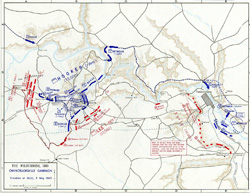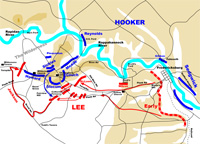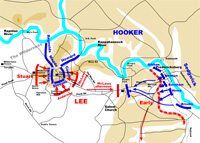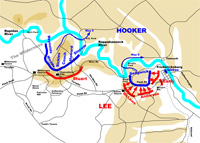 |
Civil War Battles |
|
State War Records |
| AL - AK - AZ - AR - CA - CO - CT - DE - FL - GA - HI - ID - IL - IN - IA - KS - KY - LA - MA - MD - ME - MI - MN - MS - MO - MT - NE - NV - NH - NJ - NM - NY - NC - ND - OH - OK - OR - PA - RI - SC - SD - TN - TX - UT - VT - VA - WA - WV - WI - WY |
The Battle of Chancellorsville
April 30- May 6, 1863 in Chancellorsville, Virginia
 |
|||||||||||||||||||||
|
Books on The Battle of Chancellorsville & the Chancellorsville Campaign
are available from Amazon.com
The Battle of Chancellorsville began with the Army of the Potomac, under Maj. Gen. Joseph Hooker, facing the Army of Northern Virginia, under Gen. Robert E. Lee.The two armies were still around the same areas that they possessed after the Battle of Fredericksburg on December 1862.
Hooker's bold and aggressive plan was a double envelopment of Lee's forces. Hooker would lead around 65,000 troops on a 25 mile march northwest, turning south to cross the Rappahannock River and Rapidan River, turning east, and then would be able to strike Lee's army in its rear. Maj. Gen. John Sedgewick would command 59,000 at Fredericksburg. He was to feint an attack on Lee's front while Hooker moved his army into place.
Hooker had hoped that Lee would think that Sedgewick's movement was the main attacking force. Maj. Gen. George Stoneman would lead about 10,000 cavalry in a raid deep into Lee's rear area, generally following the railroad tracks of the Virginia Central Railroad (see Stoneman's Raid).
Stoneman was to destroy the Confederate supply depots along the railroad from Richmond to Fredericksburg, which would cut Lee's lines of communication and supply. Stoneman left about 2 weeks before the battle was to start so that he would have time conduct his raids. Unfortunately, Hooker only kept 1,000 cavalrymen with his army to properly reconnaissance his route and provide flank security.
Hooker believed that faced with these multiple threats, Lee would have to abandon his defensive line along the Rappahannock River or be trapped by Hooker's superior forces and be destroyed. Stoneman would harass the retreating Confederates from their left flank and hopefully hold them in place while Hooker and Sedgewick would hit them in the rear. All of this depended on the element of surprise for Hooker's plan to work. He wanted to strike at Lee while a sizable portion was detached under Lt. Gen. James Longstreet was at Newport news to watch for a possible Union attack from the coast.
On April 13, Hooker sent Stoneman to start his raid around Lee's army. Just after a few days, Stoneman's cavalry force became bogged down by swollen rivers. Both Hooker and President Abraham Lincoln had decided to write off Stoneman's raid and proceeded to continue on with their plans.
On April 27–28, Hooker led his 4 corps across the Rappahannock and Rapidan Rivers in several places, most of them near the confluence of the 2 rivers and Chancellorsville, which was little more than a large mansion, owned by the Chancellor family. It was located at the junction of the Orange Turnpike and Orange Plank Road. In the meantime, the second force of Sedgwick's men crossed the Rappahannock River at Fredericksburg, and Stoneman's cavalry was beginning its movement to reach Lee's rear areas. After starting his movements, Hooker was to have said "May God have mercy on General Lee, for I will have none."
On April 30, Hooker had enveloped the Confederate left flank, interposing his army some 10 miles behind Lee's lines at Fredericksburg. Lee had anticipated some kind of Union movement to force his army out of its position, and had decided to wait and see what Hooker had planned before he made his decision. Lee had received reports that Sedgewick had built some pontoon bridges south of Fredericksburg across the Rappahannock River. When there was not any major Union advance across the bridges, Lee figured out that this was only a feint against his army.
Once Lee found out that Hooker had divided his army, Lee left a force of 10,000 men, under Maj. Gen. Jubal Early, behind to defend Fredericksburg while the rest of the army advanced against Hooker's force in the Wilderness. Early had placed his troops at Marye's Heights. Lt. Gen. Thomas J. "Stonewall" Jackson was to lead the Confederates toward Hooker's army.
Passing the Rapidan River by way of the Germanna Ford and Ely's Ford, the Federals concentrated near Chancellorsville on April 30 and May 1. The III Corps was ordered to join the army by coming through at the United States Ford.
On May 1, the Confederates marched westward. The Federals abandoned the Wilderness, moving into the open country. About 2 miles from the woodline, they met Jackson's men, and skirmishing erupted along the lines. As Hooker moved toward Fredericksburg on the Orange Turnpike, they encountered increasing Confederate resistance. The Union and Confederate troops clashed on the Chancellorsville front, with some Union forces actually pushing their way out of the impenetrable thickets and scrub pine in the area.
Hearing reports of the overwhelming Confederate force, Hooker ordered his army to suspend the advance and to concentrate again at Chancellorsville. Hooker ordered a sudden withdrawal into the Wilderness. Over the protests of his corps commanders, he abandoned the initiative to Lee. Pressed closely by Lee's advance, Hooker ordered his men into a defensive posture and had them dig in for the night.
Lee planned an attack for the next day. Maj. Gen. J.E.B. Stuart had provided Lee with some important information. Stuart had found out that the Union right flank was was open and unanchored to anything. Jackson proposed a risky plan of attack. Lee would split his force at Chancellorsville, with Jackson taking his II Corps of 28,000 men around to attack the Union right flank. This would roll up the flank and cut off the Union's line of retreat at the river fords. Lee, on the other hand, would command the rest of the army, facing Hooker's entire front.
For Lee's plan to work, several things had to happen. First, Jackson's 10-mile long column's march had to reach the Union right, and do it while being undetected. Second, Lee had to hope that Hooker stayed on the defensive. Third, Early would have to keep Sedgwick bottled up in Fredericksburg. And finally, when Jackson launched his attack, he had to hope that the Union forces would be unprepared and caught by surprise.
On May 2, Jackson planned to move out at 4:00 A.M. to get to the Union right flank. It took longer than anticipated to find a route for Jackson to take. His forces finally set out at 8:00 A.M., 4 hours behind schedule. Stuart's cavalry, moving at the flanks of Jackson, kept the Union forces from spotting Jackson on his long march, which took almost all day. Jackson's force was spotted by some Union troops while moving south of Chancellorsville. Around midafternoon, Hooker received reports of large numbers Confederates spotted in front of the Union line. Hooker thought that Lee was retreating and the spotted Confederates were Lee's rear guard. Therefore, Hooker did not contemplate an all-out attack, sending only his III Corps, under Maj. Gen. Daniel Sickles, forward to investigate the sightings. Sickles captured a handful of Confederates and then stopped, with Jackson's force already having passed by.
At Fredericksburg, Sedgwick and Hooker were unable to communicate with one another due to the failure of telegraph lines between the two. Hooker finally got an order to Sedgwick late in the evening, ordering him to attack Early. Sedgwick failed to do so because he had believed that Early's force was larger than his.
Maj. Gen. Oliver O. Howard, whose XI Corps were posted at the far right flank of the Union line, failed to make any provision for his defense in case of an attack, even though being ordered to by Hooker. The Union right flank was not anchored on any natural obstacle, and the only defenses against a flank attack was 2 cannon pointing out into the Wilderness.
Jackson had wasted several hours of daylight positioning his troops for the attack while still in the Wilderness. At around 5:00 P.M., with only 2 hours of daylight left, his men advanced out of the Wilderness and hit Howard's corps, catching them totally by surprise. Most of the Union soldiers were resting or cooking dinner. The Union soldiers were overrun and as soon as a defensive line was set up, it was swept away by the charging Confederates. The heavy brush and looming darkness slowed down the Confederates momentum. The Federals began to fire artillery at the Confederates, slowing them down even further. Over 4,000 Union soldiers were taken prisoner without firing a shot.
By nightfall, Jackson's force had advanced more than 2 miles and was separated from Lee only by Sickles' corps. Hooker, concerned about Sickles' ability to hold what was now a salient into the Confederate lines, pulled the III Corps back to Chancellorsville that night. This gave the Confederates two advantages—it reunited Jackson and Lee's forces, and it gave them control of an elevated clearing in the woods known as Hazel Grove, one of the few places in which artillery could be used effectively. Union troops rallied, resisted the advance, and counterattacked. The Confederates halted about 7:15 P.M. to reorganize and readjust their lines. Disorganization on both sides and darkness ended the fighting.
Having won a huge victory that day, Jackson wanted to press his advantage before Hooker and his army could regain their bearings and plan a counterattack, which might succeed because of the Union's number of troops. He and his aides left for the Union lines to plan a night attack on Hooker's forces.
While returning from making a night reconnaissance of the Union lines, Jackson and his staff came under fire from his own advance pickets of the 18th North Carolina. They did not know Jackson was returning back to the lines. Several men were shot from their horses. When one of Jackson's men yelled to cease fire, the pickets fired a second volley at them. Jackson was shot twice in his left arm and once in his right hand and 2 of his aides were killed. Maj. Gen. A.P. Hill, who was Jackson's second-in-command, took over command. He was soon injured by some shrapnel. This injury kept him from being able to walk so he passed command to Stuart.
Jackson was carried from the field and sent to the hospital at Wilderness Tavern. He had to have his left arm amputated and died of pneumonia on May 10 at a field hospital at Guinea Station. Lee was devastated by this loss and issued General Order No. 61, stating Jackson's death to his army. His remains were taken to Richmond and lay in state. The body was then taken to Lexington were he was buried. Maj. Gen. J.E.B. Stuart took temporary command of Jackson's Corps.
On May 3, Lee realized that he was in trouble. Unless he could reunite his split army, Hooker could counterattack and destroy his force. Stuart launched a massive assault all along the front. Hooker withdrew his troops from Hazel Grove, a hill nearby where he had a few artillery pieces and infantry. After this, the Confederates took over the hill and set up their artillery to bombard Union artillerymen.
During the peak of the day's fighting, Hooker again called on Sedgwick to break through and attack Lee's rear. Once again, Sedgwick delayed his movement until it was too late. He finally attacked Early's position and broke through, but it was too late in the day to help Hooker's force. Hooker suffered a minor injury when a 12-pound Confederate cannonball hit a wooden pillar he was leaning against at his headquarters. At first, Hooker's staff thought that he was killed. Although practically incapacitated, he refused to turn over command to Maj. Gen. Darius N. Couch, the second-in-command.
Fierce fighting broke out when Stuart launched another massive assault against the Union lines, which were slowly crumbling from the pressure and a lack of resupply and reinforcements.
By the afternoon, the Confederates had captured Chancellorsville, and Hooker withdrew his army a mile and entrenched in a defensive "U" with his back to the river at United States Ford, their last remaining line of retreat.
Lee left Stuart to keep Hooker holed up while he took the rest of his force towards Fredericksburg to help Early's retreating force. (see the Second Battle of Fredericksburg) Reinforcements under Maj. Gen. Lafayette McLaws arrived from Chancellorsville late in the afternoon and joined ?? Wilcox at Salem Church, 4 miles west of Fredericksburg. The combined Confederate force halted Sedgwick's march to Chancellorsville.
On May 4, Hooker remained in his defenses while Lee and Early battled Sedgwick. Sedgwick, after breaking Early's defenses the day before, had neglected to secure Fredericksburg. Early had marched back and reoccupied the Marye's Heights, cutting Sedgwick off from a retreatthrough Fredericksburg.
Meanwhile, Lee directed the division of Maj. Gen. Richard H. Anderson from the Chancellorsville front and reinforced McLaws before Sedgwick realized just how few men were opposing him. Sedgwick stood his ground that day before withdrawing back across the Rappahannock River at Banks' Ford during the pre-dawn hours of May 5.
Hooker wanted Sedgwick to hold Banks' Ford, so that Hooker could withdraw from the Chancellorsville area and re-cross the river at Banks' Ford to fight again. When he learned that Sedgwick had retreated back over the river, Hooker felt he was out of options to save the campaign. He decided that his only option was to order a retreat of his force as well.
On May 5, (see the Battle of Salem Church) Hooker's army recrossed to the north bank of the Rappahannock River during the night. Lee's had won a significant victory and Hooker had suffered an embarrassing defeat. Despite being outnumbered by a 5-to-2 Union troop advantage, Lee had arguably won his greatest victory of the war. This battle was considered by many to be an almost perfect example of military strategy.
Hooker, believing he had "80 chances in 100 to be successful", lost the battle through communications problems, the incompetence of some of his leading generals, and through some serious errors of his own.
The Northern people were shocked and dismayed by the Union defeat at Chancellorsville. President Abraham Lincoln was quoted as saying, "My God! My God! What will the country say?" He soon relieved Hooker of his command on June 28, just before the Battle of Gettysburg.




